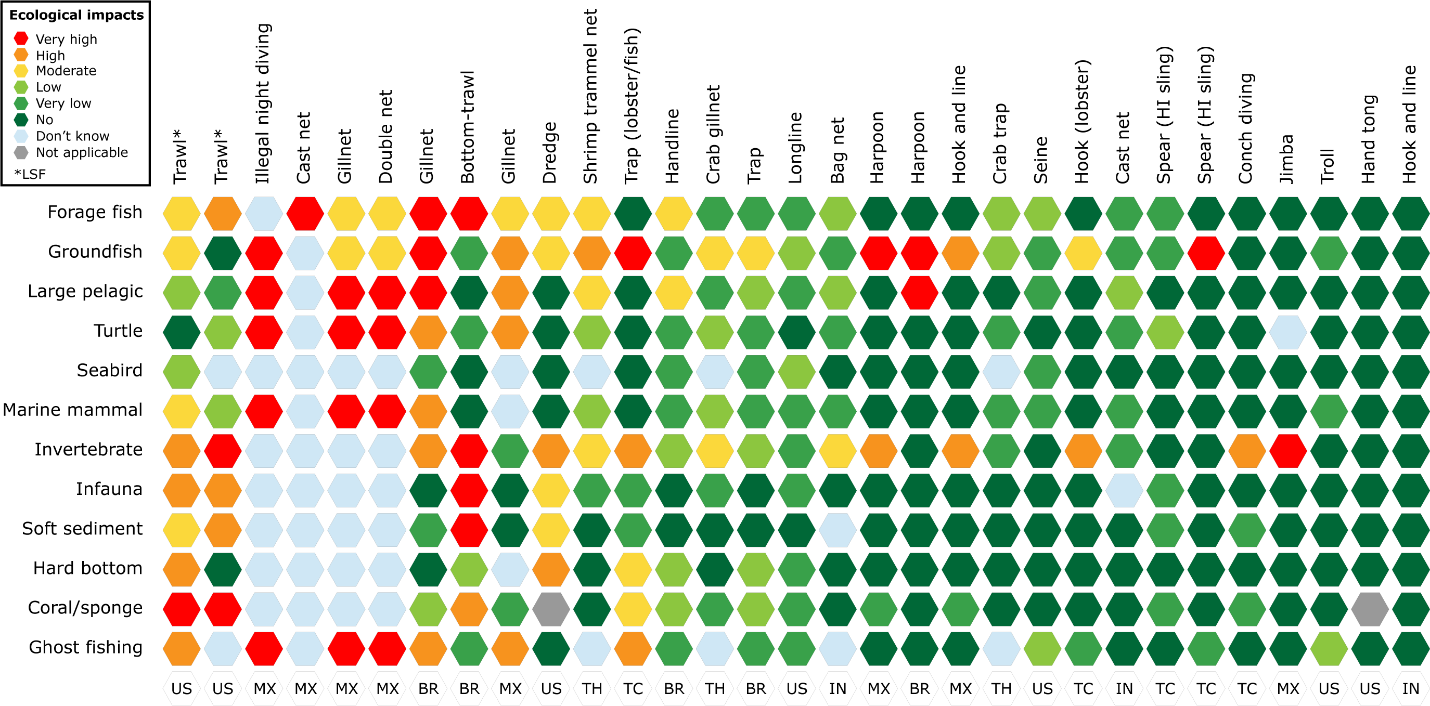When it comes to fishing gears impacts, experts suggest that habitat damage is a priority concern for fisheries management (Fuller et al. 2008). One reason behind this concern is that the recovery of seafloor habitats, on which fish and other marine life depend for survival, would take hundreds of years. By mid 90s alone, estimates showed that about 14.8 million km2 of seafloor have been trawled (Watling and Norse 1998). But habitat damage is not the only concern: bycatch - an incidental catch of marine life such as fish, mammals, and corals - is another issue associated with many fishing gears.
Recent efforts to assess relative impacts of fishing gears include work by Chuenpagdee et al. 2003 (US fisheries); Fuller et al. 2008 (Canada); Alfaro-Shigueto et al. 2010 (Peru); Crilly & Esteban 2013 (United Kingdom); Guyader et al. 2013 (European countries). These assessment, however, do not distinguish fishing gears used in the small-scale fishery and large-scale fishery, which is why the The Too Big To Ignore (TBTI) research team has been working to fill this knowledge gap. For instance, in a workshop held in St. John’s, in July 2016, TBTI conducted an expert workshop to rate the ecological impacts of fishing gears in six countries, namely Brazil, India, Mexico, Thailand, Turks and Caicos, and United States. Figure 1 shows the assessment based on the experts participating in this workshop (see Agapito et al. forthcoming publication for details).

Figure 1 Gear impact assessment from eight case studies. Numerical equivalents are from 5 (very high) to 0 (zero or negligible impact).
As shown in Figure 1, active gears, which involve the movement of the gear during the fishing activity, cause higher levels of habitat and bycatch impacts than passive gears (those left stationary in place for a period of time before retrieval). For example, bottom trawls, which scour across the seafloor, would have high to very high impacts on bottom habitat-forming species such as coral and sponges, than stationary gear, such as trammel nets, targeting the same type of demersal species. The 2005 FAO report states that “trawl fisheries and demersal finfish account for over 50 percent of total estimated discards... while finfish trawls account for 36 percent of the estimated global discards". Simultaneously, large-scale midwater active gears, including purse seine, drift net and midwater trawling, have more impact on large pelagic, mammal, turtle, groundfish, and seabird than the passive gears used in the midwater column, including gillnets, double nets, cast nets, and shrimp. Needless to say, as the gears become highly selective and smaller in size (e.g., traps, longline, harpoons, jimba), they cause fewer impacts to both habitats and bycatch.
The findings presented in Figure 1 echo other studies about gear impact in fisheries, which indicate that due to the nature of certain gears, such as bottom trawls and bottom gillnets, damage to habitats and bycatch of certain species such as finfish could be expected, whether used in small-scale or large-scale fisheries (Chuenpagdee et al. 2003, Fuller et al. 2008). However, a recent global study demonstrated that most discards are generated by industrial-large scale fisheries (Zeller et al. 2017), a problem that has been around us for decades, as reported by FAO (2005).
Apart from two cases of trawls being used for large-scale fishing, Figure 1 shows different fishing gears used in small-scale fisheries and demonstrates that, while some small-scale fishing has relatively high impacts on habitats and bycatch, many are much less damaging. So are small-scale fishing gears, in general, less destructive? Many studies suggest that, especially when we take into consideration the amount of fish caught by small-scale fisheries, compared to large-scale fisheries. If we also take into consideration the utilization of fish, there are also ample evidences to suggest that fish from small-scale fisheries are well used for household consumption (Pauly 2006). This is why the contribution of small-scale fisheries to local food security and nutrition is indisputable.















